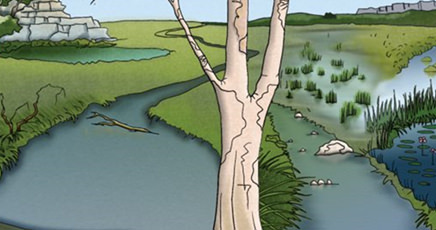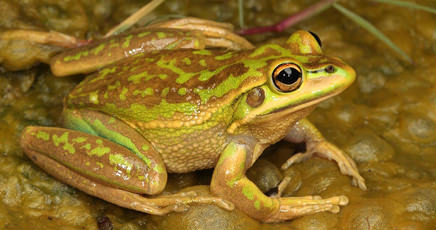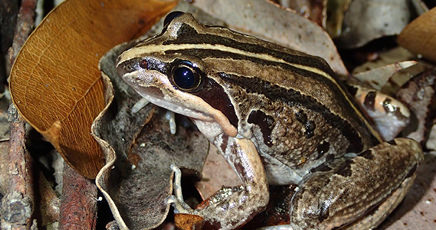LEARNING ACTIVITY
STORY
Suyin, Tom and their local Landcare group met regularly to organise all the materials and tools they needed for their project. Many people offered to support them by donating equipment, native and aquatic plants as well as their time as volunteers. On the day of the community working bee, it became very clear to Suyin and Tom how much protecting the local frogs meant to the community. There were so many volunteers. While it took a lot of hard work and effort, Suyin and Tom beamed as they finally laid the last of the plants and rocks and the safety signage. They couldn’t believe that they have just created a frog-friendly pond!

The lack of suitable habitat is a real threat to frogs across Australia. With research and thoughtful design processes, you can take action and create a frog-friendly habitat on your property, at school or in your local community garden. This will require good preparation, resourcing and a great team of patient and diligent helpers. Restoration of habitats increases the land’s ability to support frog populations and helps connect frog communities.
This learning activity is the third part of a sequence of 3 individual learning activities focused on creating a frog-friendly habitat. The order of these learning activities are: research, design and construction.
For children to:
- understand that they can help support frog species through creation and restoration of their habitat
- appreciate the planning and materials required to create a frog-friendly habitat
- learn how to create a healthy pond environment
- value the needs of local frog species, their aquatic breeding and foraging habitat and to be able to construct that habitat for them.
While this activity can be undertaken any time of year, undertaking this project during times of predictable rainfall is preferable. Natural rainfall will fill the pond and enable young learners to observe where the water pools naturally in your area.
During spring and summer, run this as a morning activity to avoid heat stress for people and plants.
Introduction
There is a comprehensive list of safety and planning considerations, and materials to gather before commencing the construction of a frog pond. Please refer to the educator notes via the button above. Before commencing this activity, the Junior Landcarers will have already created a habitat design, informed by their research to guide this next construction phase of the project. This activity will require adult supervision and some ground work to prepare and move materials. Adequate preparation of materials beforehand and following safety instructions are vital. Having several volunteers to contribute and help when others need a break will ensure this is an effective and efficient activity.
*The time allocation for this activity is based on all materials being sourced prior to commencing construction. Most of the construction materials can be sourced from a local hardware store; and the native aquatic plants and shrubs from a local indigenous plant nursery. It is difficult to advise on how long it will take to dig the pond hole - as this is site and soil specific.
Checklist
Instructions
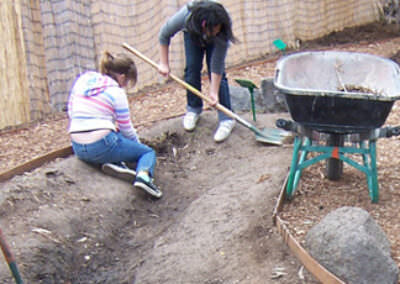
STEP 1
Once you have gathered all the necessary materials and carefully selected a suitable location for your frog-friendly pond, it’s time to get digging!
Dig out a hole approximately 30cm deep, and as wide as your area allows. Make sure the edges of the pond are level: Use a spirit level to check (Should you choose to have varying depths in your pond, a spirit level will not be necessary). Include gently sloping sides to allow frogs to get in and out of the pond easily.
If you are including an overflow pond, be sure to dig out this hole at the same time. The overflow pond will need to be dug out in a location lower than and adjacent to the frog pond.
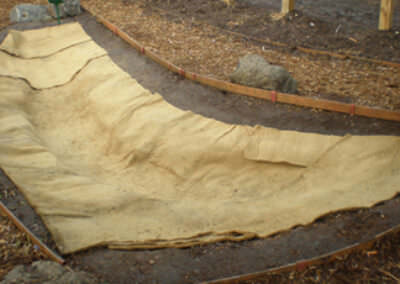
STEP 2
Use the soil removed from the hole to create mounds and undulations near the pond.
Once dug, line the hole with sand, old carpet or hessian bags, which smooths any edges and helps protect the liner.
Lay the pond liner across the sand/soft materials. Layer the base of the lined empty pond with gravel or clean sand.
Add locally-native aquatic plants in pots in the shallowest region, and place a few at the opposite end. Cover the plants with soil or sand and weigh down with a rock if required. The plants will provide habitat for the tadpoles to shelter in while they are small and most vulnerable to predators.
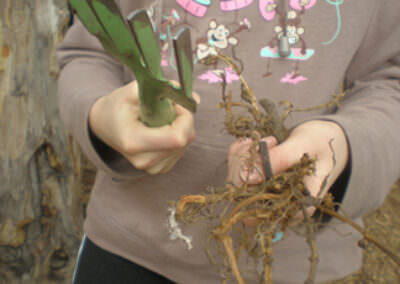
STEP 3
Before adding water to your pond, ensure your water supply is free of chemicals, rainwater is a good option. If using tap water. Chlorine will dissipate within a week if left to stand, however other chemicals may require you to use water conditioner.
For a healthy pond, add a bucket of water from a nearby natural pond if available.
Place rocks and tree branches (removing any sharp ends) in the pond as resting (basking) and climbing places for frogs.
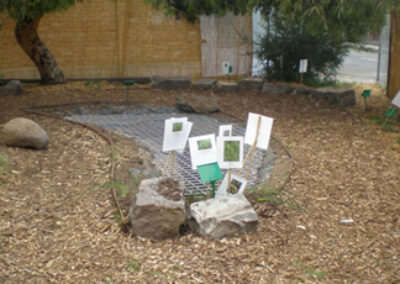
STEP 4
Plant selected native grasses and shrubs densely along the edge of the pond, for hiding spaces and to attract an insect food supply for the frogs.
Place additional rocks, logs, leaf litter and bark around the pond. Create a moist environment around the pond by watering the ground or mulching it. Newly morphed frogs have a better chance of surviving in a place with lots of moisture.
Use the activity sheet to create signage to keep the frogs and your frog-friendly habitat safe.
Be patient; frogs may take up to two years to begin settling into your frog-friendly habitat – it will be worth the wait!
Extension Activity
Create a boundary around the pond with a low fence, log seating or large rocks. Continue to develop the habitat around your pond to encourage a range of animals including frogs to the area.
Continue to monitor your frog pond to look for signs of habitation. Start a class journal that documents the changes observed over time and submit any sightings to Frog ID to keep a valuable record of frog populations for citizen science. Support citizen science and run special events during FrogID Week.
Curriculum and Framework Links
SCIENCE
Year 2: ACSSU031, ACSHE035
Year 3: ACSSU044, ACSHE051
Year 4: ACSHE062, ACSSU073, ACSSU075
Year 5: ACSSU043, ACSHE083
Year 6: ACSSU094, ACSHE100
Year 7: ACSSU112, ACSHE120
Year 8: ACSHE135
Year 9: ACSSU176
GEOGRAPHY
Year 9: ACHGK061
DESIGN & TECHNOLOGIES
Foundation to Year 2: ACTDEP005, ACTDEP006, ACTDEP009
Years 3 & 4: ACTDEK012, ACTDEP015, ACTDEP017
Years 5 & 6: ACTDEK021, ACTDEK023, ACTDEP025, ACTDEP026
Years 7 & 8: ACTDEP036, ACTDEP039
Years 9 & 10: ACTDEP049
CRITICAL AND CREATIVE THINKING:
Generating ideas, possibilities and actions
PERSONAL AND SOCIAL CAPABILITY:
Social awareness
CROSS CURRICULUM PRIORITY
Aboriginal and Torres Straight Islanders Histories and Cultures
Sustainability
My Time, Our Place: Framework for School Age Care
Outcome 2 and 4
Reference List
ONLINE RESOURCES
This Frog ID habitat poster from the Australian Museum provides great information on how to create your own frog habitat.
Learn some essential design steps for a building a frog pond from Backyard Buddies.
Frog pond design ideas with some Frog Bog basics from Sustainable Gardening Australia.
Advice and tips on making a frog hotel from the Australian Geographic.
WATCH
In this Gardening Australia video look at the construction of a frog bog habitat in an early childhood centre. (10 minutes)
Frog Pond Fix-Up this follow up video looks at some of the mistakes from the building the frog bog and revitalising it with special plants, and features. (6 minutes)
IMAGE ATTRIBUTION
Feature image: Litoria pearsoniana Four Bulls Creek, Washpool NP from Australian Museum – FrogID
Other images:
Green and Golden Bell Frog Litoria aurea from Australian Museum – FrogID
Striped Marsh Frog Limnodynastes peronii from Australian Museum – FrogID
The Pacific Blue Eye from from Australian Museum – FrogID
Just for Kids
Check out our fun activity Australian frog quiz
We value your feedback
When you have finished this learning activity, please tell us what you think with our survey.
Your feedback will help Landcare Australia improve the activities in the Junior Landcare Learning Centre.
Why not try one of our other Junior Landcare learning activities?
Creating a butterfly garden
Biodiversity
Love Letters to the Land
Biodiversity|First Nations Perspectives|Food Production|Waste Management
Creating a sensory garden
Biodiversity
Understanding weeds: life cycle
Biodiversity
